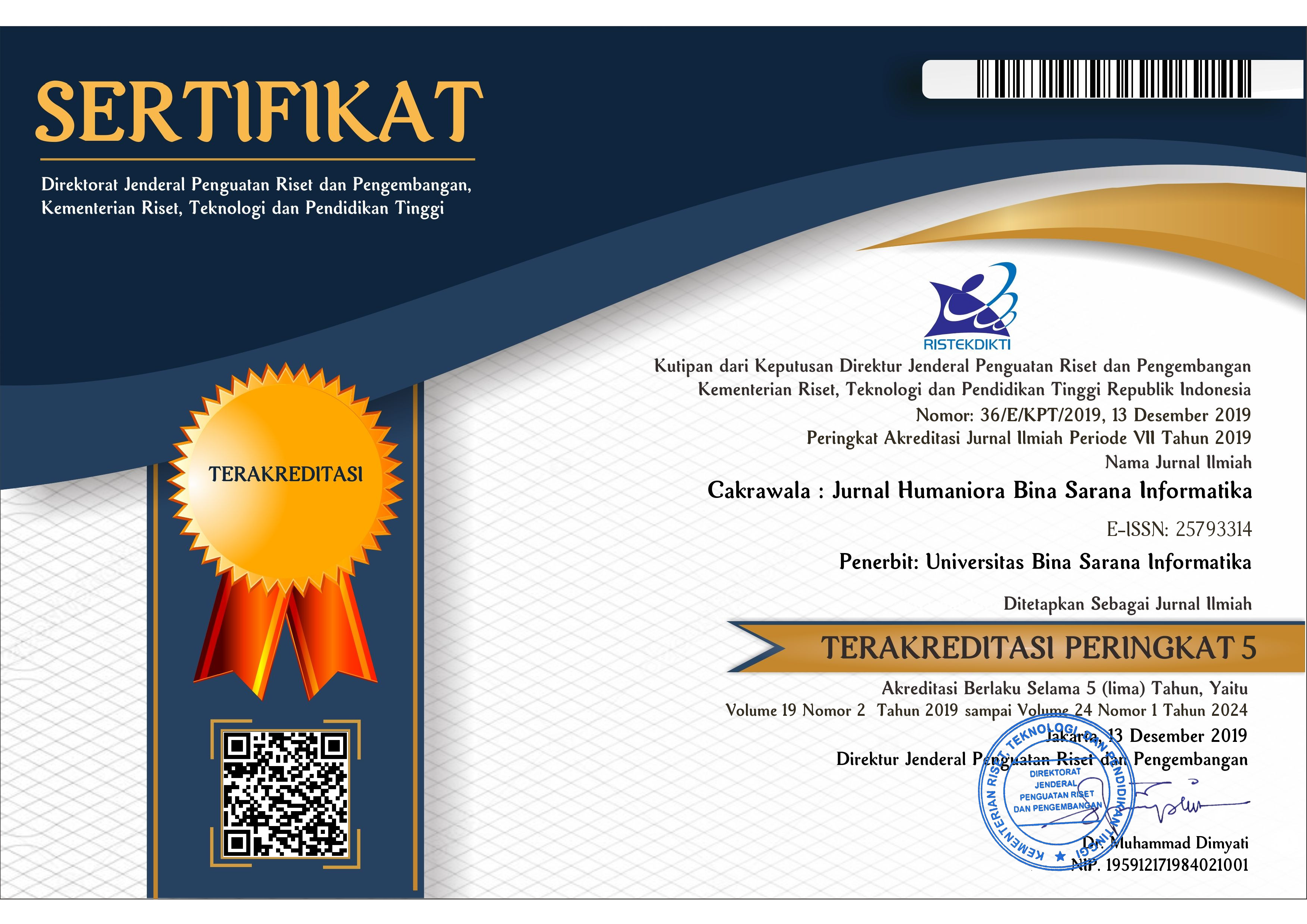PENGARUH KUALITAS PRODUK DAN PELAYANAN TERHADAP KEPUASAN PELANGGAN PT. DISTRIVERSA BUANA Studi Kasus pada pemakai Balsem cap Macan di Jakarta
Abstract
The objective of the research is to know the effect of the product quality and service to
customer satisfaction. This study was carried out at Jakarta Greater Area with 100
respondents. Which were taken by propotional random sampling. The respondents were
people who was user of Tiger Balm and live at Jakarta greater area.Data anlysis techniques
are used to test the hypothesis is correlation and multiple regression were oprated by
computer using Statistical Product & Service Solution (SPSS). Computational results for
testing the model showed analysis of determination, and anlysis non parametrik regression.
The results show the quality of product and service is a significant positive effect and
correlation between quality product and service on customer satisfaction. The better the
quality of the product it will be a positive impact on customer satisfaction. High-quality of
services are services that can exceed the expectations of the consumer, the better the service
received by the customer it will be a positive impact on customer satisfaction.
Full Text:
PDFReferences
Achrol, Ravi S. (1991). Evolution of Marketing Organization New Form for turbulence and Environment. Journal of Marketing, 55, 77-93.
Arief,F (1997). Pengantar penelitian dalam pendidikan. Yogyakarta : Pustaka Pelajar.
Anderson, Eugne W., Claes Fornell, Donald R.Lehman (1994).Customer satisfaction, market share and prifitability: Findings from Sweden. Journal of Marketing, 58.
Andreassen, T. W. (1994). Satisfaction, Loyalty and Reputation as Indicator of Customer Orientation in the public sector. International Journal of Public sector Management, 7, 16-34.
Dharmmesta, Basu Swastha. (1997, June). Pergeseran paradigma dalam pemasaran, tinjauan manajerial dan perilaku konsumen, Jakarta.
Birgelen, Marcel Van, Ko De Ruyter, Martin Wetzel. (2000). The impact of incomplete information on the use of marketing research intelligence in international service settings. Journal of Service Research, 2, 4.
Boulding. William., Kalra. Ajay.,Staelin. Richard.,Zeithaml Valerie. (1993). A dynamic process model of service quality: from expectation to behavioral intentions. Journal of Marketing Research, XX, 7-27.
Cooper, D.R., Emory,C.W. (1995). Metode Penelitian Bisnis (5th ed.). Jakarta : Erlangga.
Cronin, J., Joseph, J.R., Steven, A. Taylor. (1992). Measuring service quality : A re-examination and extention. Journal of Marketing,56.
De Ruyter, Ko., Wetzel, Martin, G.M. (2000). The impact of perceived listening behavior in voice to voice service encouters. Journal of Service Research, 2, 3.
Duffy, Jo., Ann, M., Alice, A. Ketchand. (1998). Examining the role of service quality in overall service satisfaction. Journal of Managerial Issues, 10, 240-255.
Danaher, P.J., Mattson,J. (1994).Customer satisfaction during the service delivery process. Europan Journal of Marketing,28, 5-16.
Engel, James.F., Blackwell, Roger.D.,Miniard, Paul.W. (1991). Perilaku Konsumen (6th ed). Jakarta : Binarupa Aksara.
Ferdinant,A.T. (2000, Januari). Manajemen Pemasaran: Sebuah pendekatan stratejik, research paper series, seri penelitian manajemen.
Ferdinant,A.T. (2000). Structural Equation Modelling dalam penelitian manajemen. Jakarta:Seri pustaka kunci.
Fornell, Claes, Michael,D., Johnson, Eugene,W., Anderson.(1996). American customer satisfaction index : nature, purpose and findings. Journal of Marketing, (vol.60).
Gale, Bradley,T. (1998). Introduction to customer satisfaction, Loyalty and value : satisfaction is not enough. Marketing News. (p.1-6). Garvin, David.A. (1993). The art and science of bussines management. New York : Kent publishing.
Goering, Patrick.A. (1985). Effect of product trial on customer expectation, demand and price. Journal of consumer Research, 12, 74-84.
Gothiel, Gawel, Brown. (1994). Strategy of orientation of the firm and new product performance. Journal of Marketing, 34, 77-90.
Gozali. (2006). Aplikasi analisis multivariate dengan program SPSS (4th ed). Semarang : Badan penerbitUniversitas Diponegoro. Q
Gujarati,D. (1997). Ekometrika Dasar. Jakarta : Erlangga.
Henry,Simamora.,Bilson. (2003).Memenangkan pasar dengan pemasaran efektif dan profitabel.
Jakarta: Gramedia Pustaka Utama
Hurley,Robert,F.,Hooman. Estelami.(1998). Alternative for monitoring customer perception of service quality: A comparative evaluation in retail context. Journal of Academy of Marketing Science, 26, 209-221.
Kotler,Philip., Gary, Armastrong.(1996). Principle of management. New York : Prentice Hall Inc.
Kotler,Philip. (2000). Marketing Management,International edition (Millenium ed). New Jersey: Prentice Hall International.
Kotler, Philip. (2001). Manajemen Pemasaran : Analisis perencanaan, implementasi dan kontrol (Hendra teguh & Ronny Antonius Rusli, Penerjemah.). Jakarta : Prehallindo
Liu, M.C.(2005). The multi dimentional and hirerarchical structure of perceived quality and customer satisfaction. International Journal of Management, 22,3.
Likert. (1932). A Technique for measurement of attitudes.140
Menon, Ajay., Jaworski, Bernard & Kohli,Ajay,K.(1997). Product Quality:Impact of interdeparmental interactions. Journal of the academy ofMarketing Science, 25, 187-200.
Mital, V, Ross,W.T., Baldasare,P.M. (1998). The symmetric impact of negative and positive attribute level performance on overall satisfaction and repurchase intentions. Journal of Marketing, 60, 33-47.
Morgan,R,M., Hunt,S.D.(1994). The commitment- Trust Theory of Relationship Marketing. Journal of Marketing, (vol.60).
Oliver,Richard. (1993). A conceptual model of service quality and service satisfaction : compatible goals, Different concept, Advance in service marketing and management. Journal of
Marketing, (vol.2).
Patterson, Wilson (1992). Analisis kualitas pelayanan dan persepsi harga terhadap kepuasan pelanggan. Journal Nasional, (vol.21,no.3).
Parasuraman,A., Zeithaml & Berry, L.I (1988). Serqual a multiple item scale for measuring consumer perception of service quality. Journal of Retailing, 64, 12-14.
Putrawan. (1990). Pengujian hipotesis dalam penelitian-penelitian sosial. Jakarta: Rineka Cipta.
Peter, J., Paul, Olson, Jerry,C. (1993). Consumer behavior:Perilaku konsumen dan strategy pemasaran (4thed). Jakarta : Erlangga.
Selness Fred.(1993). An examination of effect of product performance on brand reputation,satisfaction and loyalty. Europan Journal of Marketing, 27, 19-35.
Scheter, Edwin. S. (1992). Managing for world class quality. New York:ASQC Quality Press.
Tjiptono, Fandy. (2006). Pemasaran Jasa. Malang:Bayumedia Publishing.
Tjiptono,Fandy. (2008). Strategy pemasaran (3rd ed). Yogyajarta:Andi
Woodruff, Robert,B., Gardial, Sarah,F. (1996). A comparison of customervalue and satisfaction. Journal of bussines strategy. 17, 3.
Yi, Y. (1989). A critical review marketing : American Marketing Association.(66-123). Chicago.
Zeithmal, Valerie,A. (1988). Consumer perceptions of price, Quality and Value: a means – end model and synthesis of evidence. Journal of Marketing, 52, 2-22.
Zeithmal, Valerie,A., Mary, Jo, Bitner., Dwayney,D.Gemler. (2006). Service marketing. Integrating customer focus a cross the firm (4th ed). International Edition. Singapore: Mc Graw-Hill.
DOI: https://doi.org/10.31294/jc.v16i2.1288
ISSN: 2579-3314


Dipublikasikan oleh LPPM Universitas Bina Sarana Informatika
Jl. Kramat Raya No.98, Kwitang, Kec. Senen, Kota Jakarta Pusat, DKI Jakarta 10450

This work is licensed under a Creative Commons Attribution-ShareAlike 4.0 International License









